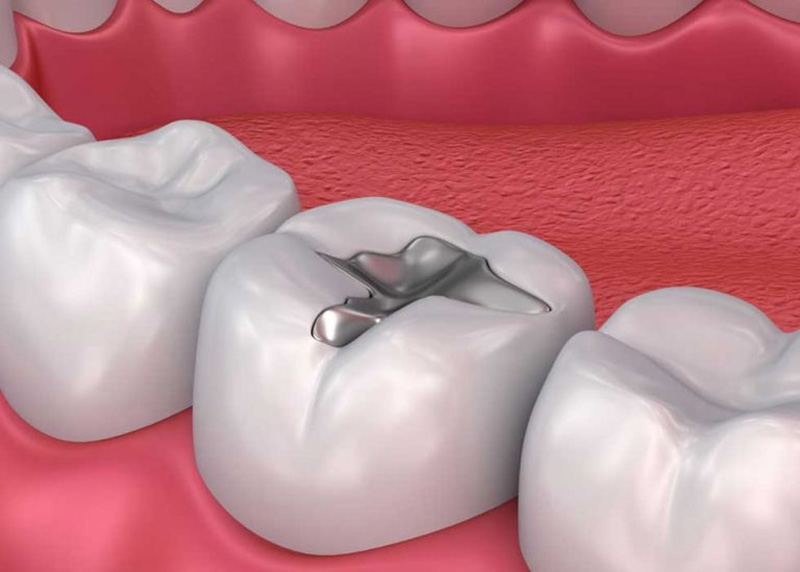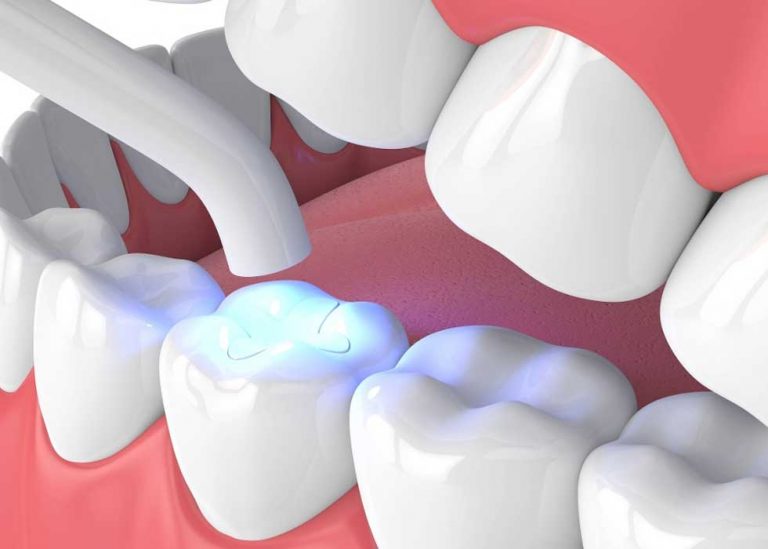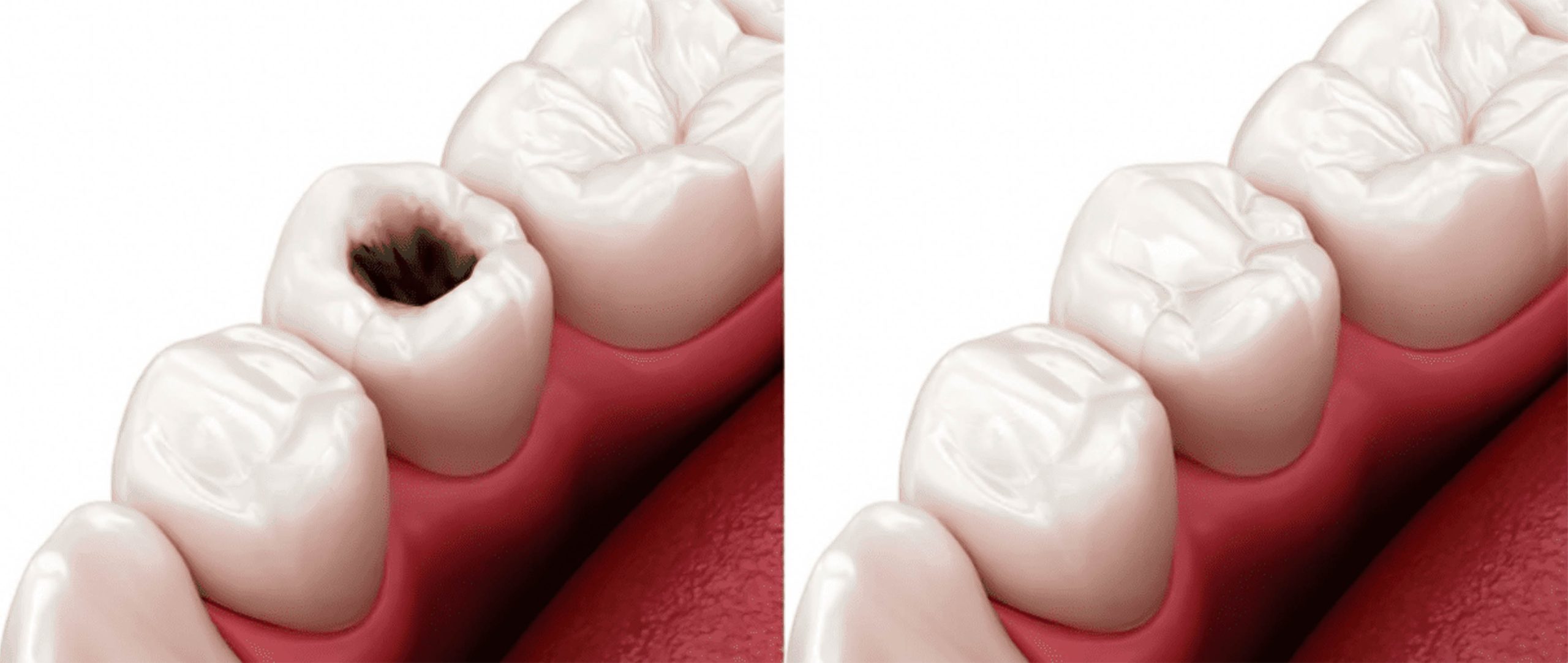



Booking
What is Dental Filling?
Dental filling is a method that uses dental materials such as composite, amalgam, gold, and porcelain to fill the area of decayed tooth tissue, restoring its shape and improving chewing function. The safe and medically-standard dental filling process at Hoa Mỹ is carried out as follows:
- Examination, X-ray imaging, and assessment of the decayed tooth condition.
- The dentist will clean the area to be filled and administer anesthesia.
- Select appropriate filling material and proceed with the dental filling.
- Adjust the filling, refine aesthetics, and complete the dental filling process.


What Are the Current Dental Filling Materials?
The superior dental filling materials available today include:
Composite: The composite filling method is used for cases with small cavities. This material closely matches the color of natural teeth, providing good aesthetics while also offering decent strength, being non-toxic to the body, and allowing for a relatively quick procedure. However, the lifespan of a composite filling is only about 5 years, and it may discolor over time.
Inlay, Onlay: This is a new trend in aesthetic dental fillings applied in cases of larger cavities or broken teeth. With inlays and onlays, patients do not need to grind down all the surfaces of the tooth as with crowns, thus preserving more natural tooth structure. Furthermore, inlays and onlays have high durability and strong adhesion, making them a suitable alternative to full crowns. Additionally, filling teeth with inlays and onlays typically requires only 30–45 minutes per treatment session for patients to achieve a strong, healthy tooth.

Other Materials
In addition to the materials mentioned above, dental filling techniques also utilize materials such as amalgam, SonicFill, and GIC (glass ionomer cement). These materials vary in durability, lifespan, and cost, so patients should consult their dentist to choose the appropriate filling material.
Cases That Require Dental Filling
Dental filling is the optimal solution for the following cases:

Individuals with decayed teeth, whether they have small or large cavities.

Individuals with old fillings that are cracked or broken, requiring replacement.

Individuals with teeth that are chipped due to trauma or chewing on hard foods.

Dental Filling Process at the Dental Clinic
When you visit a dental clinic for examination, the dentist will recommend dental filling when encountering issues such as decayed teeth, chipped teeth, gaps between teeth, or replacing old fillings, using the most common and suitable filling materials for your current dental condition.
Direct Dental Filling Process

Examination and Consultation: Take X-rays, assess the condition, and recommend appropriate filling materials.

Anesthesia & Cleaning the Filling Area: Administer anesthesia at the site and clean tartar and food debris.

Fill with Material: Place the filling material into the cavity and use a laser light to cure the filling material.

Adjust the Filling: The dentist will adjust and remove any excess material to prevent discomfort and ensure a smooth finish.
Indirect Dental Filling Process

Examination and Consultation: Take X-rays, assess the condition, and recommend appropriate filling materials.

Anesthesia & Cleaning the Filling Area: Administer anesthesia at the site and clean tartar and food debris.

Take Impressions: Create an impression of the tooth to shape the filling according to its form and size, and schedule a follow-up appointment after a few days to complete the filling.

Attach the Filling to the Tooth: Using specialized cement material.
Important Considerations After Dental Filling
- In the first two hours after the filling, limit eating or drinking to allow the filling material time to adapt to the oral environment and ensure the filling hardens securely onto the tooth.
- Avoid consuming tough, hard, or highly adhesive foods. Refrain from biting too hard or grinding your teeth, as this can exert pressure on the filling, causing it to dislodge.
- Practice gentle oral hygiene using a soft-bristled toothbrush. It is advisable to check the filling and overall oral health every six months.
Quick Answers to Common Questions About Tooth Decay & Dental Filling
It depends on the condition of the tooth. For mild decay with small cavities, the dentist will recommend a filling. In cases where the decay has spread significantly, leading to large broken tooth structure and pulp death, extraction may be necessary to prevent further impact on the remaining teeth.
Preserving the natural tooth as much as possible is always the top priority for dentists at Hoa Mỹ. A filling will be recommended when the cavity is small, the tooth structure is intact, and it does not affect the pulp chamber that nourishes the tooth. A crown will be performed when the decay is extensive, and a filling would not provide optimal results.
Wisdom teeth are the last to emerge and often cause many oral issues. Filling a decayed wisdom tooth should only be considered if it is fully erupted, the cavity is not too large, and it does not affect adjacent teeth.
Dental filling is a technique that involves removing harmful cavities from the tooth and using specialized materials to fill the cavity. This method helps improve chewing function and provides high aesthetic value. However, there are many cases where a filled tooth can decay again. The reasons include poor oral hygiene, an unhealthy diet, and inadequate filling techniques by the dentist, which can lead to recurrent tooth decay.
A tooth with a large cavity can be filled; however, it is important to choose appropriate materials and filling methods. Since a large cavity requires a larger filling area, if the filling material does not have high durability, it may easily dislodge due to daily eating and drinking.
It will depend on factors such as the equipment used, the filling materials, and most importantly, the skill of the dentist. Therefore, to achieve optimal treatment results, you should prioritize choosing a reputable dental clinic with experienced dentists. During the procedure, the dentist will effectively manage any tooth pain, thereby minimizing your discomfort as much as possible.
It depends on the severity of the decay. If bacteria have completely destroyed the enamel and dentin, attacking the pulp and causing pain, then a root canal treatment will be necessary. The purpose of performing a root canal is to maximize the preservation of the natural tooth and prevent complications for both oral health and overall health.
WEE Dental - Caring with dedication - Elevating value.
- Address: 127 Luong Dinh Cua, Quarter 3, An Khanh Ward, District 2, Thu Duc City, Ho Chi Minh City.
- Hotline: 0362 790 924
- Website: weedental.vn
- Fanpage: https://www.facebook.com/weedental.fanpage/
Detailed Consultation on
Costs and Plans for
Orthodontics
Thousands of customers have beautiful, healthy smiles with proper occlusion and harmonious aesthetics.

